Managing Innovation: Diffusion of Innovation Theory and its Application in BrewDog
VerifiedAdded on 2023/01/13
|11
|3414
|28
AI Summary
This article explores the Diffusion of Innovation theory and its application in BrewDog, a global pub chain and brewery. It explains how innovation theory helps in understanding consumer adoption of new products and how BrewDog used it to become a market leader in the beer industry. The article discusses the stages of the theory, evaluation of its benefits and limitations, and the future development plans of BrewDog.
Contribute Materials
Your contribution can guide someone’s learning journey. Share your
documents today.
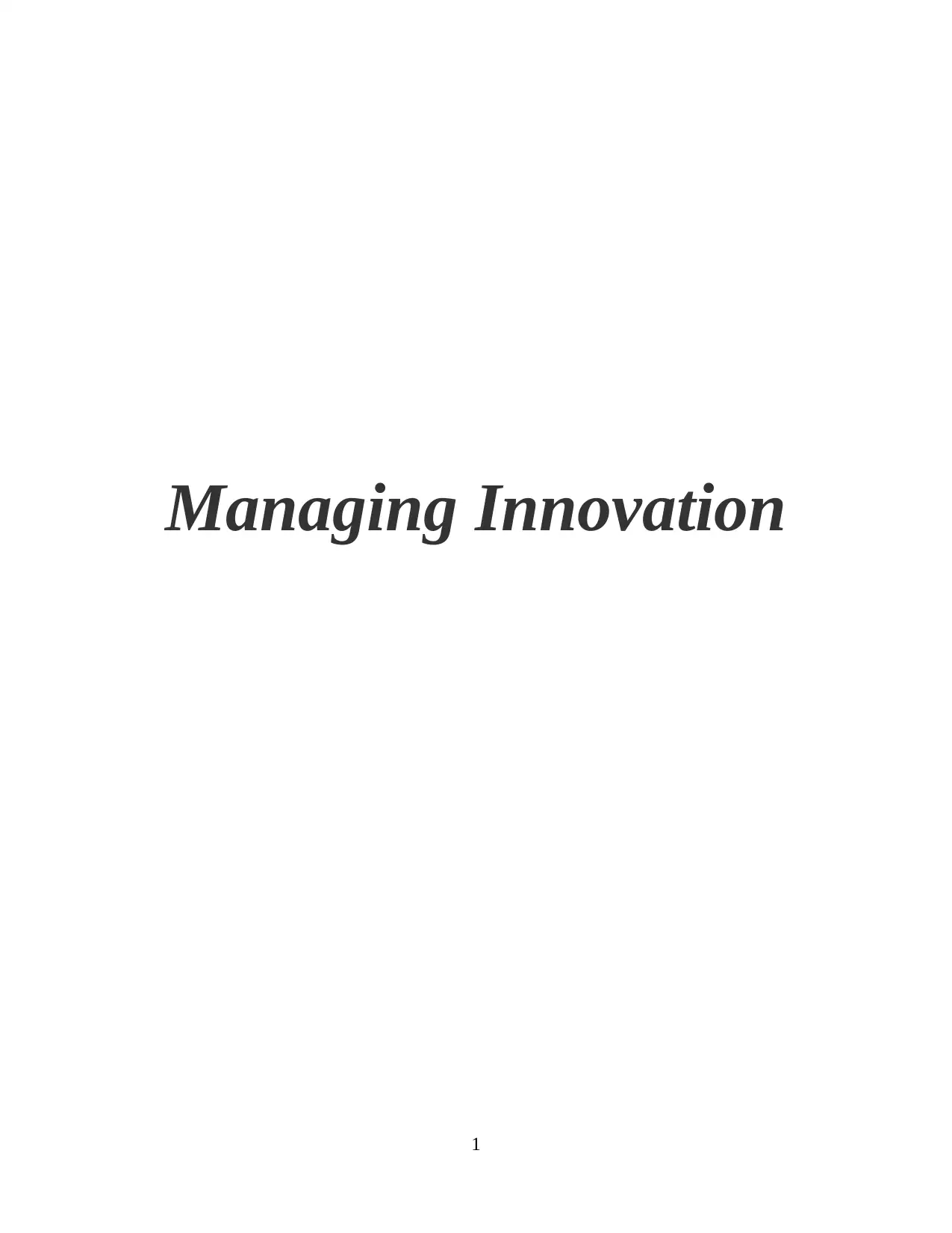
Managing Innovation
1
1
Secure Best Marks with AI Grader
Need help grading? Try our AI Grader for instant feedback on your assignments.
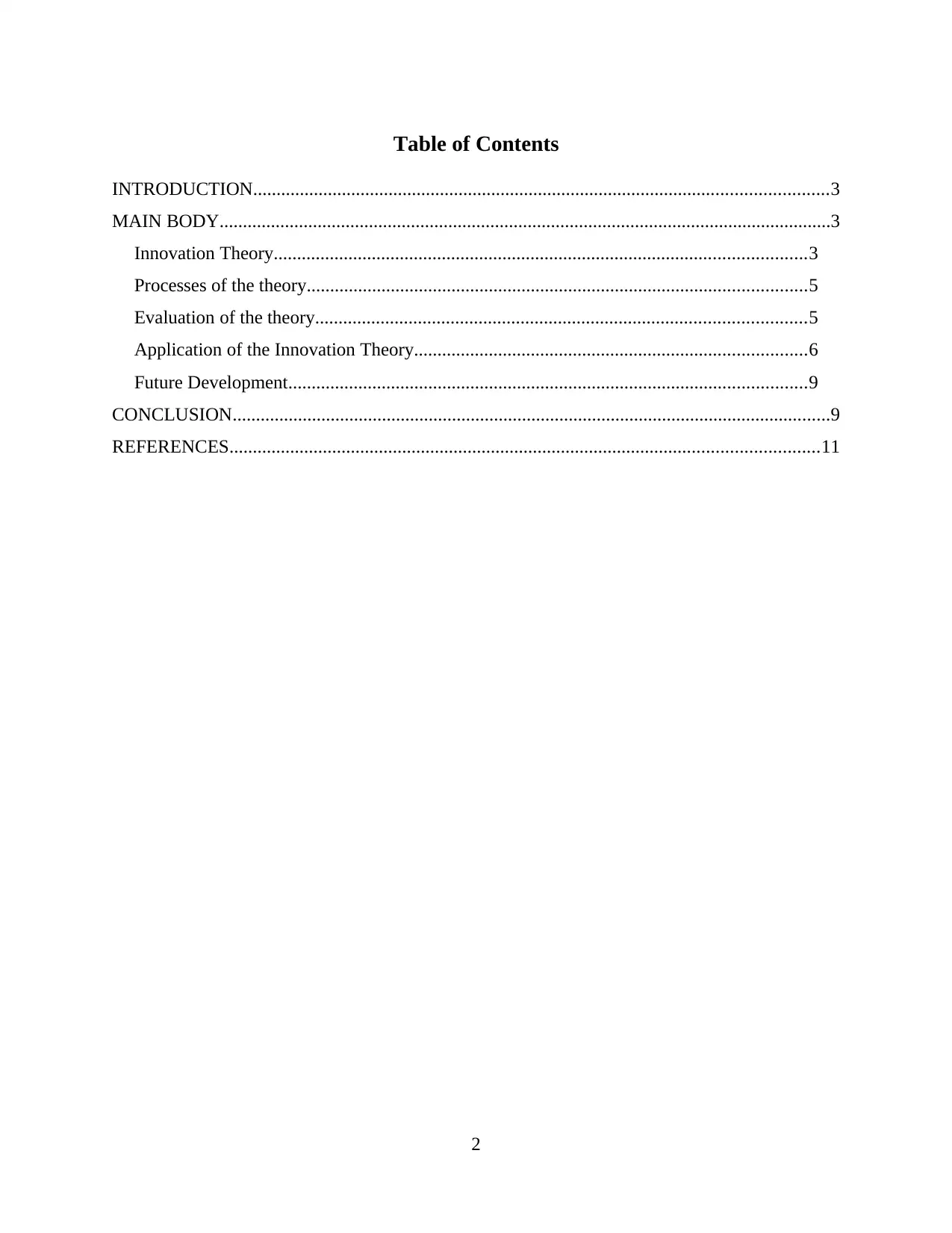
Table of Contents
INTRODUCTION...........................................................................................................................3
MAIN BODY...................................................................................................................................3
Innovation Theory..................................................................................................................3
Processes of the theory...........................................................................................................5
Evaluation of the theory.........................................................................................................5
Application of the Innovation Theory....................................................................................6
Future Development...............................................................................................................9
CONCLUSION................................................................................................................................9
REFERENCES..............................................................................................................................11
2
INTRODUCTION...........................................................................................................................3
MAIN BODY...................................................................................................................................3
Innovation Theory..................................................................................................................3
Processes of the theory...........................................................................................................5
Evaluation of the theory.........................................................................................................5
Application of the Innovation Theory....................................................................................6
Future Development...............................................................................................................9
CONCLUSION................................................................................................................................9
REFERENCES..............................................................................................................................11
2
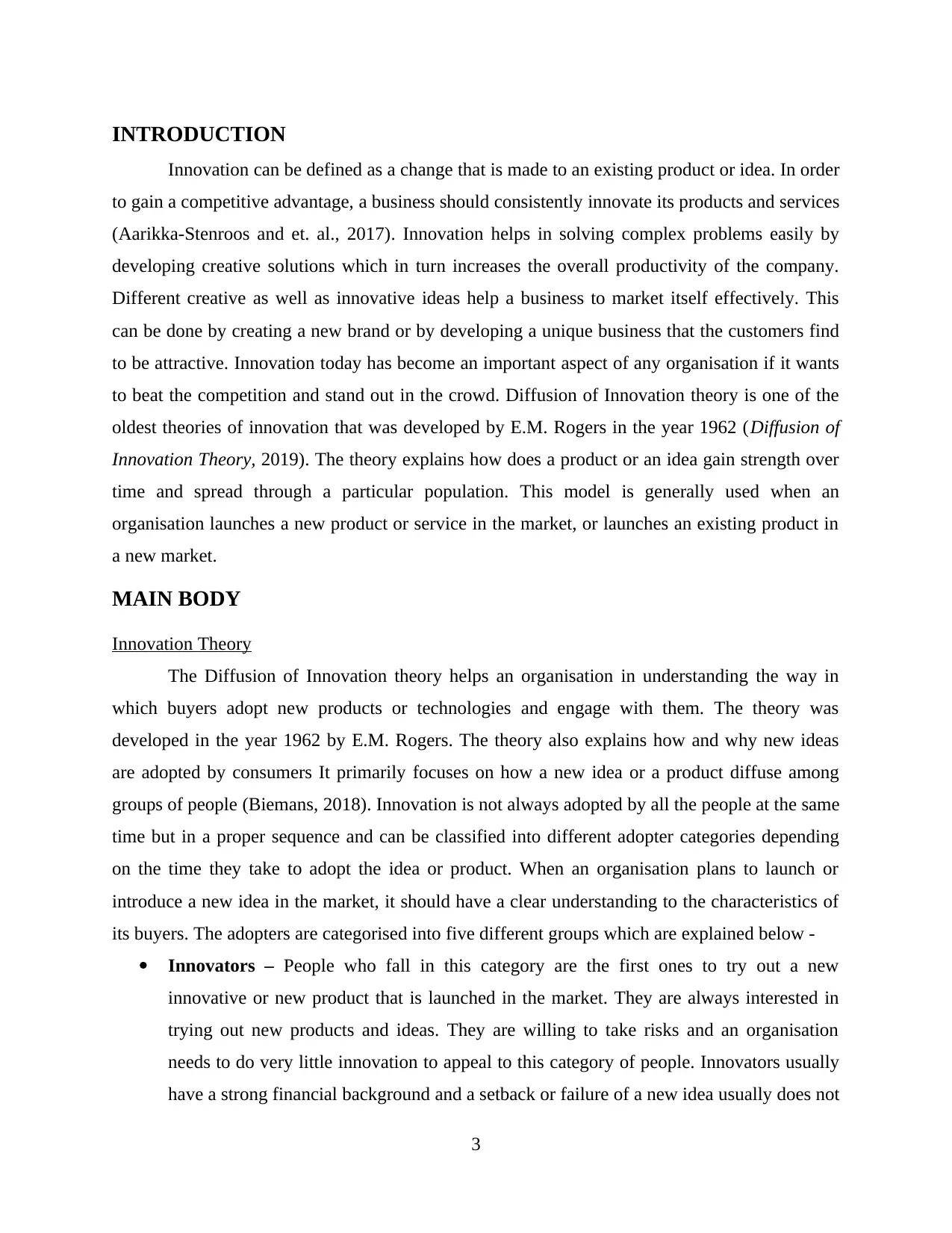
INTRODUCTION
Innovation can be defined as a change that is made to an existing product or idea. In order
to gain a competitive advantage, a business should consistently innovate its products and services
(Aarikka-Stenroos and et. al., 2017). Innovation helps in solving complex problems easily by
developing creative solutions which in turn increases the overall productivity of the company.
Different creative as well as innovative ideas help a business to market itself effectively. This
can be done by creating a new brand or by developing a unique business that the customers find
to be attractive. Innovation today has become an important aspect of any organisation if it wants
to beat the competition and stand out in the crowd. Diffusion of Innovation theory is one of the
oldest theories of innovation that was developed by E.M. Rogers in the year 1962 (Diffusion of
Innovation Theory, 2019). The theory explains how does a product or an idea gain strength over
time and spread through a particular population. This model is generally used when an
organisation launches a new product or service in the market, or launches an existing product in
a new market.
MAIN BODY
Innovation Theory
The Diffusion of Innovation theory helps an organisation in understanding the way in
which buyers adopt new products or technologies and engage with them. The theory was
developed in the year 1962 by E.M. Rogers. The theory also explains how and why new ideas
are adopted by consumers It primarily focuses on how a new idea or a product diffuse among
groups of people (Biemans, 2018). Innovation is not always adopted by all the people at the same
time but in a proper sequence and can be classified into different adopter categories depending
on the time they take to adopt the idea or product. When an organisation plans to launch or
introduce a new idea in the market, it should have a clear understanding to the characteristics of
its buyers. The adopters are categorised into five different groups which are explained below -
Innovators – People who fall in this category are the first ones to try out a new
innovative or new product that is launched in the market. They are always interested in
trying out new products and ideas. They are willing to take risks and an organisation
needs to do very little innovation to appeal to this category of people. Innovators usually
have a strong financial background and a setback or failure of a new idea usually does not
3
Innovation can be defined as a change that is made to an existing product or idea. In order
to gain a competitive advantage, a business should consistently innovate its products and services
(Aarikka-Stenroos and et. al., 2017). Innovation helps in solving complex problems easily by
developing creative solutions which in turn increases the overall productivity of the company.
Different creative as well as innovative ideas help a business to market itself effectively. This
can be done by creating a new brand or by developing a unique business that the customers find
to be attractive. Innovation today has become an important aspect of any organisation if it wants
to beat the competition and stand out in the crowd. Diffusion of Innovation theory is one of the
oldest theories of innovation that was developed by E.M. Rogers in the year 1962 (Diffusion of
Innovation Theory, 2019). The theory explains how does a product or an idea gain strength over
time and spread through a particular population. This model is generally used when an
organisation launches a new product or service in the market, or launches an existing product in
a new market.
MAIN BODY
Innovation Theory
The Diffusion of Innovation theory helps an organisation in understanding the way in
which buyers adopt new products or technologies and engage with them. The theory was
developed in the year 1962 by E.M. Rogers. The theory also explains how and why new ideas
are adopted by consumers It primarily focuses on how a new idea or a product diffuse among
groups of people (Biemans, 2018). Innovation is not always adopted by all the people at the same
time but in a proper sequence and can be classified into different adopter categories depending
on the time they take to adopt the idea or product. When an organisation plans to launch or
introduce a new idea in the market, it should have a clear understanding to the characteristics of
its buyers. The adopters are categorised into five different groups which are explained below -
Innovators – People who fall in this category are the first ones to try out a new
innovative or new product that is launched in the market. They are always interested in
trying out new products and ideas. They are willing to take risks and an organisation
needs to do very little innovation to appeal to this category of people. Innovators usually
have a strong financial background and a setback or failure of a new idea usually does not
3
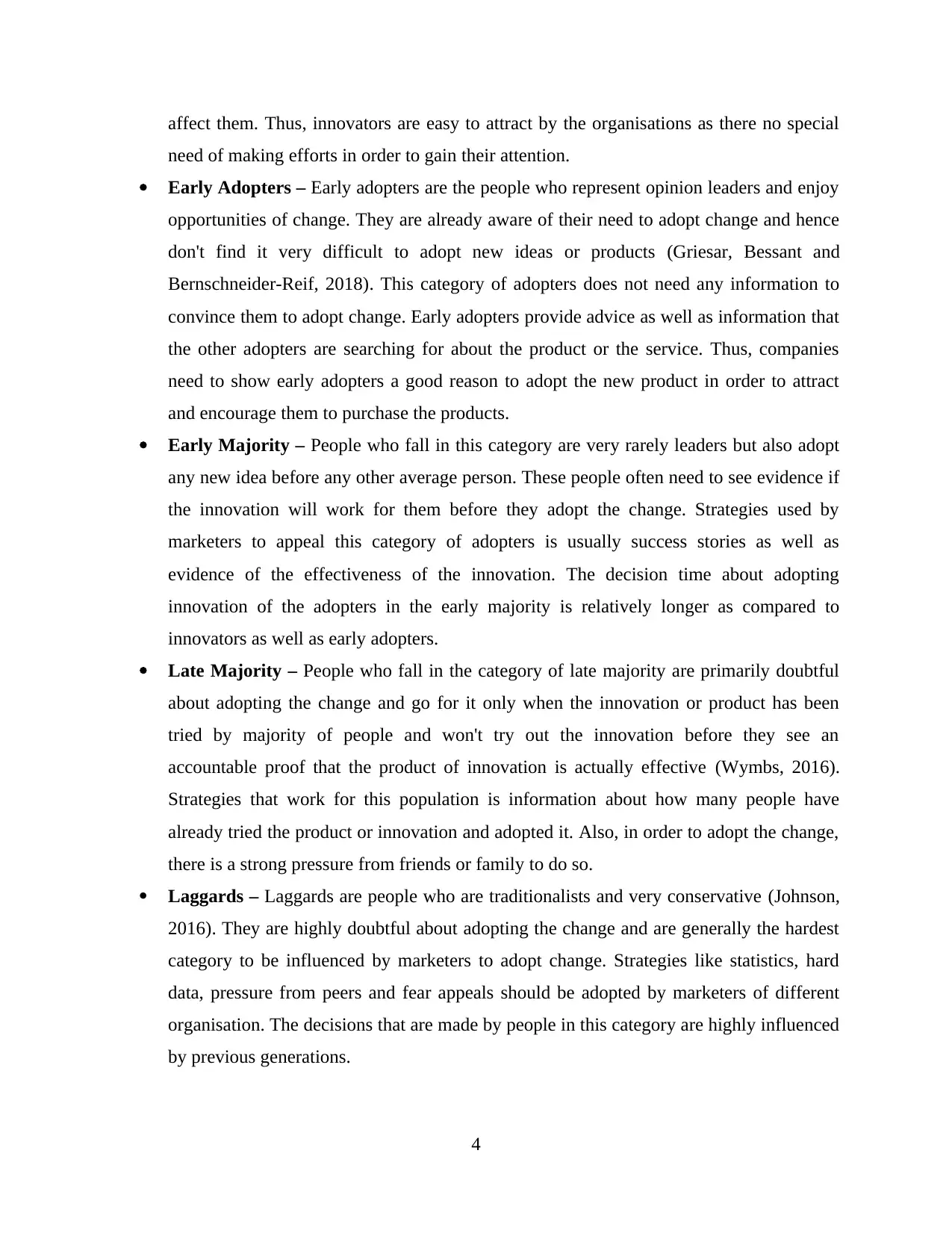
affect them. Thus, innovators are easy to attract by the organisations as there no special
need of making efforts in order to gain their attention.
Early Adopters – Early adopters are the people who represent opinion leaders and enjoy
opportunities of change. They are already aware of their need to adopt change and hence
don't find it very difficult to adopt new ideas or products (Griesar, Bessant and
Bernschneider‐Reif, 2018). This category of adopters does not need any information to
convince them to adopt change. Early adopters provide advice as well as information that
the other adopters are searching for about the product or the service. Thus, companies
need to show early adopters a good reason to adopt the new product in order to attract
and encourage them to purchase the products.
Early Majority – People who fall in this category are very rarely leaders but also adopt
any new idea before any other average person. These people often need to see evidence if
the innovation will work for them before they adopt the change. Strategies used by
marketers to appeal this category of adopters is usually success stories as well as
evidence of the effectiveness of the innovation. The decision time about adopting
innovation of the adopters in the early majority is relatively longer as compared to
innovators as well as early adopters.
Late Majority – People who fall in the category of late majority are primarily doubtful
about adopting the change and go for it only when the innovation or product has been
tried by majority of people and won't try out the innovation before they see an
accountable proof that the product of innovation is actually effective (Wymbs, 2016).
Strategies that work for this population is information about how many people have
already tried the product or innovation and adopted it. Also, in order to adopt the change,
there is a strong pressure from friends or family to do so.
Laggards – Laggards are people who are traditionalists and very conservative (Johnson,
2016). They are highly doubtful about adopting the change and are generally the hardest
category to be influenced by marketers to adopt change. Strategies like statistics, hard
data, pressure from peers and fear appeals should be adopted by marketers of different
organisation. The decisions that are made by people in this category are highly influenced
by previous generations.
4
need of making efforts in order to gain their attention.
Early Adopters – Early adopters are the people who represent opinion leaders and enjoy
opportunities of change. They are already aware of their need to adopt change and hence
don't find it very difficult to adopt new ideas or products (Griesar, Bessant and
Bernschneider‐Reif, 2018). This category of adopters does not need any information to
convince them to adopt change. Early adopters provide advice as well as information that
the other adopters are searching for about the product or the service. Thus, companies
need to show early adopters a good reason to adopt the new product in order to attract
and encourage them to purchase the products.
Early Majority – People who fall in this category are very rarely leaders but also adopt
any new idea before any other average person. These people often need to see evidence if
the innovation will work for them before they adopt the change. Strategies used by
marketers to appeal this category of adopters is usually success stories as well as
evidence of the effectiveness of the innovation. The decision time about adopting
innovation of the adopters in the early majority is relatively longer as compared to
innovators as well as early adopters.
Late Majority – People who fall in the category of late majority are primarily doubtful
about adopting the change and go for it only when the innovation or product has been
tried by majority of people and won't try out the innovation before they see an
accountable proof that the product of innovation is actually effective (Wymbs, 2016).
Strategies that work for this population is information about how many people have
already tried the product or innovation and adopted it. Also, in order to adopt the change,
there is a strong pressure from friends or family to do so.
Laggards – Laggards are people who are traditionalists and very conservative (Johnson,
2016). They are highly doubtful about adopting the change and are generally the hardest
category to be influenced by marketers to adopt change. Strategies like statistics, hard
data, pressure from peers and fear appeals should be adopted by marketers of different
organisation. The decisions that are made by people in this category are highly influenced
by previous generations.
4
Secure Best Marks with AI Grader
Need help grading? Try our AI Grader for instant feedback on your assignments.
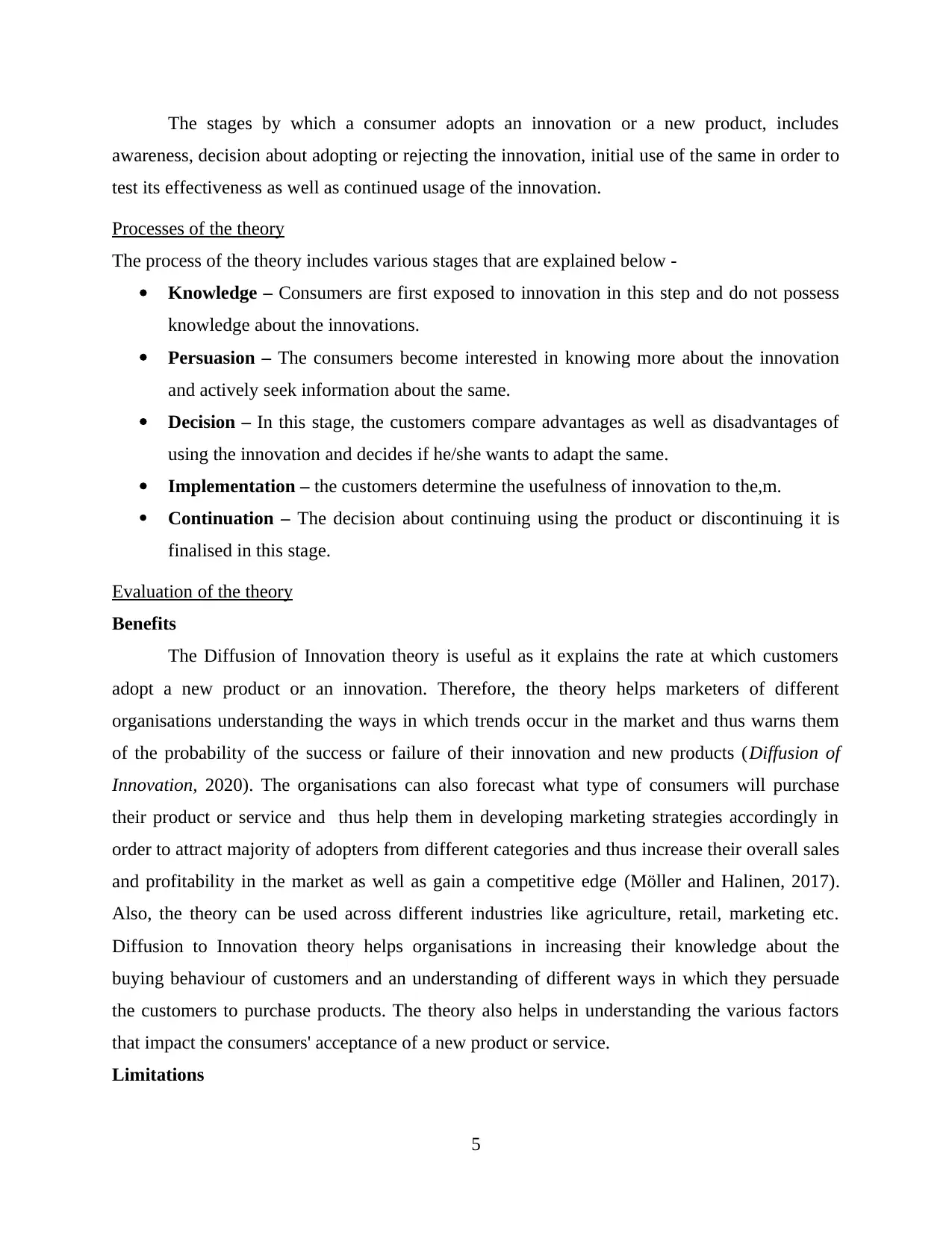
The stages by which a consumer adopts an innovation or a new product, includes
awareness, decision about adopting or rejecting the innovation, initial use of the same in order to
test its effectiveness as well as continued usage of the innovation.
Processes of the theory
The process of the theory includes various stages that are explained below -
Knowledge – Consumers are first exposed to innovation in this step and do not possess
knowledge about the innovations.
Persuasion – The consumers become interested in knowing more about the innovation
and actively seek information about the same.
Decision – In this stage, the customers compare advantages as well as disadvantages of
using the innovation and decides if he/she wants to adapt the same.
Implementation – the customers determine the usefulness of innovation to the,m.
Continuation – The decision about continuing using the product or discontinuing it is
finalised in this stage.
Evaluation of the theory
Benefits
The Diffusion of Innovation theory is useful as it explains the rate at which customers
adopt a new product or an innovation. Therefore, the theory helps marketers of different
organisations understanding the ways in which trends occur in the market and thus warns them
of the probability of the success or failure of their innovation and new products (Diffusion of
Innovation, 2020). The organisations can also forecast what type of consumers will purchase
their product or service and thus help them in developing marketing strategies accordingly in
order to attract majority of adopters from different categories and thus increase their overall sales
and profitability in the market as well as gain a competitive edge (Möller and Halinen, 2017).
Also, the theory can be used across different industries like agriculture, retail, marketing etc.
Diffusion to Innovation theory helps organisations in increasing their knowledge about the
buying behaviour of customers and an understanding of different ways in which they persuade
the customers to purchase products. The theory also helps in understanding the various factors
that impact the consumers' acceptance of a new product or service.
Limitations
5
awareness, decision about adopting or rejecting the innovation, initial use of the same in order to
test its effectiveness as well as continued usage of the innovation.
Processes of the theory
The process of the theory includes various stages that are explained below -
Knowledge – Consumers are first exposed to innovation in this step and do not possess
knowledge about the innovations.
Persuasion – The consumers become interested in knowing more about the innovation
and actively seek information about the same.
Decision – In this stage, the customers compare advantages as well as disadvantages of
using the innovation and decides if he/she wants to adapt the same.
Implementation – the customers determine the usefulness of innovation to the,m.
Continuation – The decision about continuing using the product or discontinuing it is
finalised in this stage.
Evaluation of the theory
Benefits
The Diffusion of Innovation theory is useful as it explains the rate at which customers
adopt a new product or an innovation. Therefore, the theory helps marketers of different
organisations understanding the ways in which trends occur in the market and thus warns them
of the probability of the success or failure of their innovation and new products (Diffusion of
Innovation, 2020). The organisations can also forecast what type of consumers will purchase
their product or service and thus help them in developing marketing strategies accordingly in
order to attract majority of adopters from different categories and thus increase their overall sales
and profitability in the market as well as gain a competitive edge (Möller and Halinen, 2017).
Also, the theory can be used across different industries like agriculture, retail, marketing etc.
Diffusion to Innovation theory helps organisations in increasing their knowledge about the
buying behaviour of customers and an understanding of different ways in which they persuade
the customers to purchase products. The theory also helps in understanding the various factors
that impact the consumers' acceptance of a new product or service.
Limitations
5
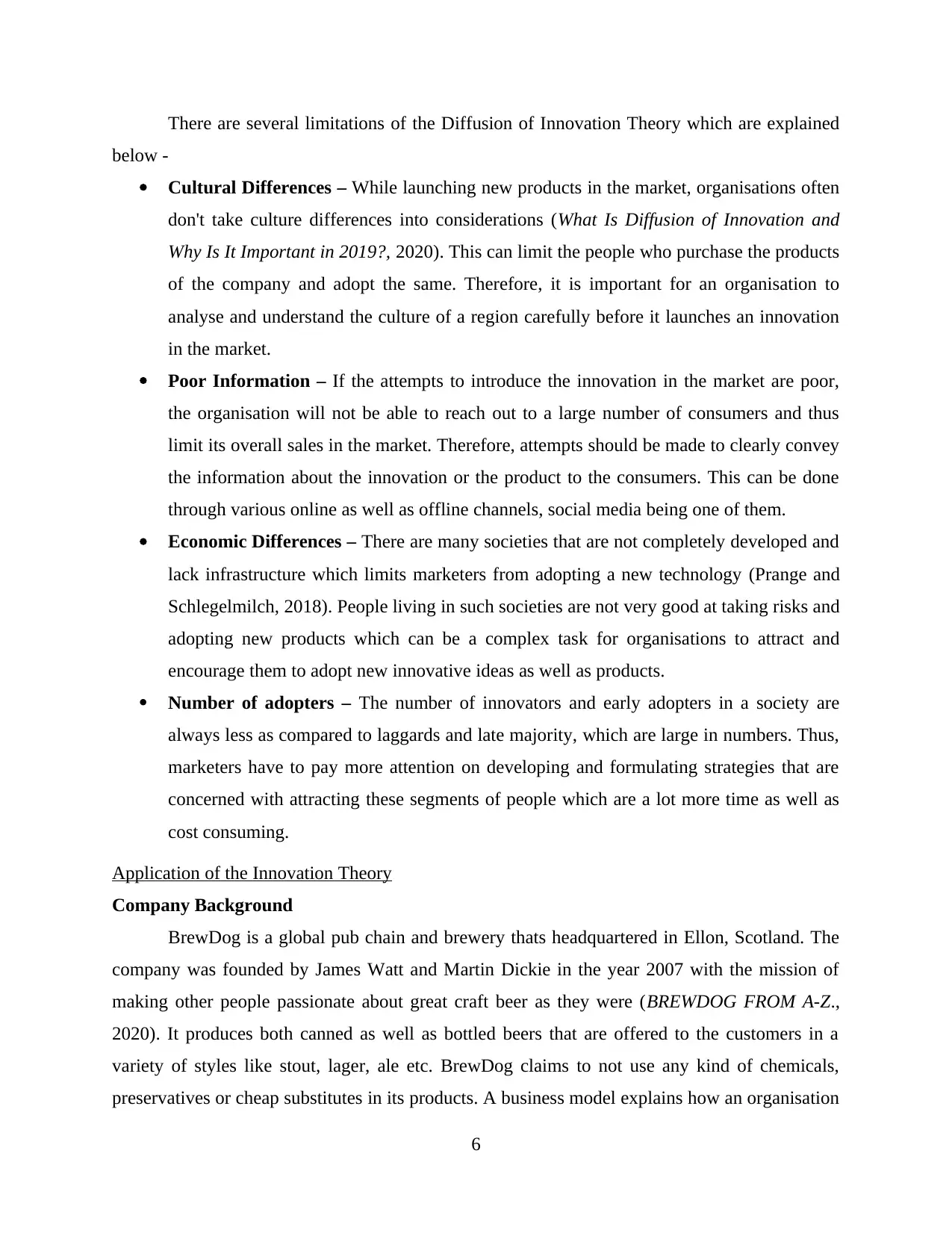
There are several limitations of the Diffusion of Innovation Theory which are explained
below -
Cultural Differences – While launching new products in the market, organisations often
don't take culture differences into considerations (What Is Diffusion of Innovation and
Why Is It Important in 2019?, 2020). This can limit the people who purchase the products
of the company and adopt the same. Therefore, it is important for an organisation to
analyse and understand the culture of a region carefully before it launches an innovation
in the market.
Poor Information – If the attempts to introduce the innovation in the market are poor,
the organisation will not be able to reach out to a large number of consumers and thus
limit its overall sales in the market. Therefore, attempts should be made to clearly convey
the information about the innovation or the product to the consumers. This can be done
through various online as well as offline channels, social media being one of them.
Economic Differences – There are many societies that are not completely developed and
lack infrastructure which limits marketers from adopting a new technology (Prange and
Schlegelmilch, 2018). People living in such societies are not very good at taking risks and
adopting new products which can be a complex task for organisations to attract and
encourage them to adopt new innovative ideas as well as products.
Number of adopters – The number of innovators and early adopters in a society are
always less as compared to laggards and late majority, which are large in numbers. Thus,
marketers have to pay more attention on developing and formulating strategies that are
concerned with attracting these segments of people which are a lot more time as well as
cost consuming.
Application of the Innovation Theory
Company Background
BrewDog is a global pub chain and brewery thats headquartered in Ellon, Scotland. The
company was founded by James Watt and Martin Dickie in the year 2007 with the mission of
making other people passionate about great craft beer as they were (BREWDOG FROM A-Z.,
2020). It produces both canned as well as bottled beers that are offered to the customers in a
variety of styles like stout, lager, ale etc. BrewDog claims to not use any kind of chemicals,
preservatives or cheap substitutes in its products. A business model explains how an organisation
6
below -
Cultural Differences – While launching new products in the market, organisations often
don't take culture differences into considerations (What Is Diffusion of Innovation and
Why Is It Important in 2019?, 2020). This can limit the people who purchase the products
of the company and adopt the same. Therefore, it is important for an organisation to
analyse and understand the culture of a region carefully before it launches an innovation
in the market.
Poor Information – If the attempts to introduce the innovation in the market are poor,
the organisation will not be able to reach out to a large number of consumers and thus
limit its overall sales in the market. Therefore, attempts should be made to clearly convey
the information about the innovation or the product to the consumers. This can be done
through various online as well as offline channels, social media being one of them.
Economic Differences – There are many societies that are not completely developed and
lack infrastructure which limits marketers from adopting a new technology (Prange and
Schlegelmilch, 2018). People living in such societies are not very good at taking risks and
adopting new products which can be a complex task for organisations to attract and
encourage them to adopt new innovative ideas as well as products.
Number of adopters – The number of innovators and early adopters in a society are
always less as compared to laggards and late majority, which are large in numbers. Thus,
marketers have to pay more attention on developing and formulating strategies that are
concerned with attracting these segments of people which are a lot more time as well as
cost consuming.
Application of the Innovation Theory
Company Background
BrewDog is a global pub chain and brewery thats headquartered in Ellon, Scotland. The
company was founded by James Watt and Martin Dickie in the year 2007 with the mission of
making other people passionate about great craft beer as they were (BREWDOG FROM A-Z.,
2020). It produces both canned as well as bottled beers that are offered to the customers in a
variety of styles like stout, lager, ale etc. BrewDog claims to not use any kind of chemicals,
preservatives or cheap substitutes in its products. A business model explains how an organisation
6
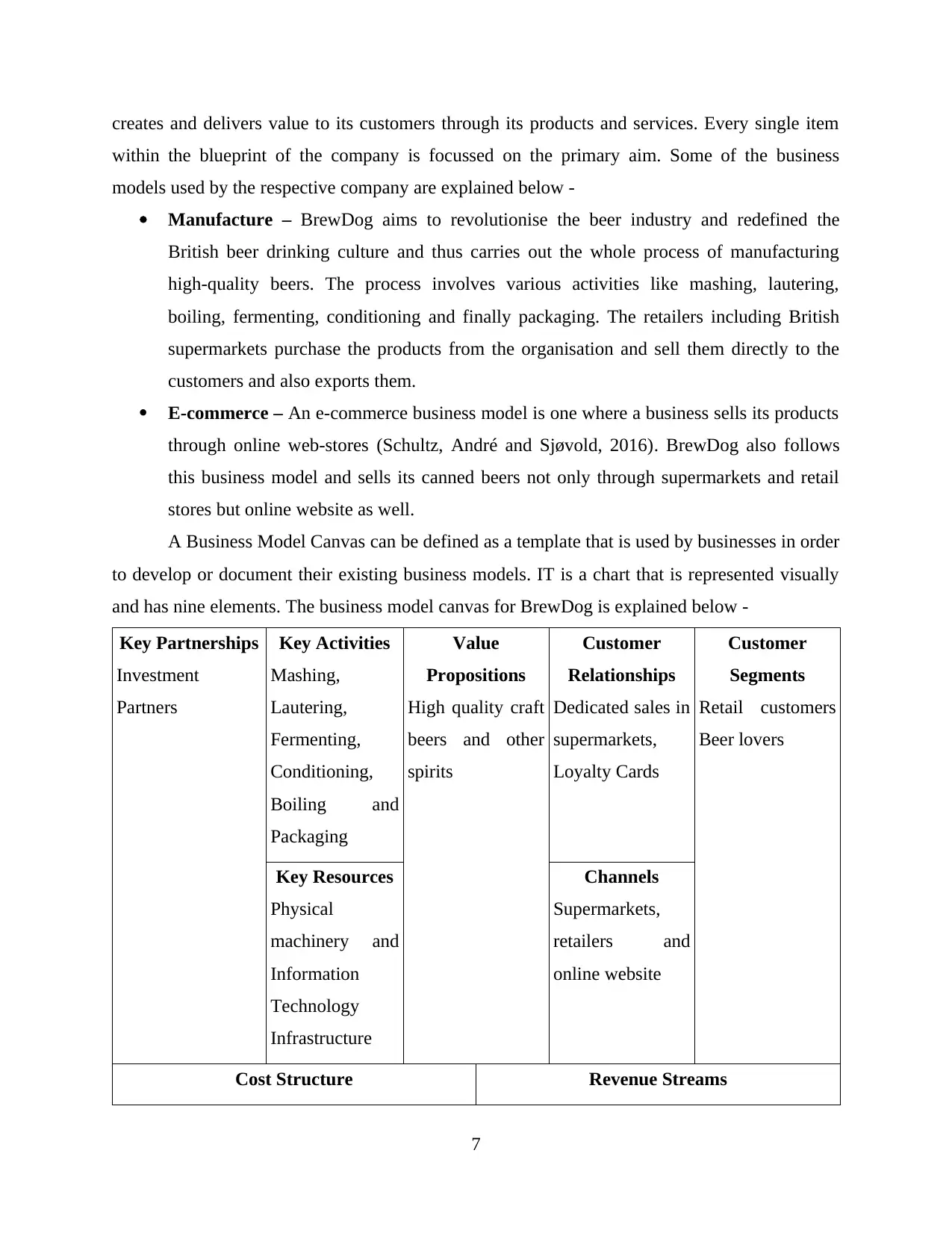
creates and delivers value to its customers through its products and services. Every single item
within the blueprint of the company is focussed on the primary aim. Some of the business
models used by the respective company are explained below -
Manufacture – BrewDog aims to revolutionise the beer industry and redefined the
British beer drinking culture and thus carries out the whole process of manufacturing
high-quality beers. The process involves various activities like mashing, lautering,
boiling, fermenting, conditioning and finally packaging. The retailers including British
supermarkets purchase the products from the organisation and sell them directly to the
customers and also exports them.
E-commerce – An e-commerce business model is one where a business sells its products
through online web-stores (Schultz, André and Sjøvold, 2016). BrewDog also follows
this business model and sells its canned beers not only through supermarkets and retail
stores but online website as well.
A Business Model Canvas can be defined as a template that is used by businesses in order
to develop or document their existing business models. IT is a chart that is represented visually
and has nine elements. The business model canvas for BrewDog is explained below -
Key Partnerships
Investment
Partners
Key Activities
Mashing,
Lautering,
Fermenting,
Conditioning,
Boiling and
Packaging
Value
Propositions
High quality craft
beers and other
spirits
Customer
Relationships
Dedicated sales in
supermarkets,
Loyalty Cards
Customer
Segments
Retail customers
Beer lovers
Key Resources
Physical
machinery and
Information
Technology
Infrastructure
Channels
Supermarkets,
retailers and
online website
Cost Structure Revenue Streams
7
within the blueprint of the company is focussed on the primary aim. Some of the business
models used by the respective company are explained below -
Manufacture – BrewDog aims to revolutionise the beer industry and redefined the
British beer drinking culture and thus carries out the whole process of manufacturing
high-quality beers. The process involves various activities like mashing, lautering,
boiling, fermenting, conditioning and finally packaging. The retailers including British
supermarkets purchase the products from the organisation and sell them directly to the
customers and also exports them.
E-commerce – An e-commerce business model is one where a business sells its products
through online web-stores (Schultz, André and Sjøvold, 2016). BrewDog also follows
this business model and sells its canned beers not only through supermarkets and retail
stores but online website as well.
A Business Model Canvas can be defined as a template that is used by businesses in order
to develop or document their existing business models. IT is a chart that is represented visually
and has nine elements. The business model canvas for BrewDog is explained below -
Key Partnerships
Investment
Partners
Key Activities
Mashing,
Lautering,
Fermenting,
Conditioning,
Boiling and
Packaging
Value
Propositions
High quality craft
beers and other
spirits
Customer
Relationships
Dedicated sales in
supermarkets,
Loyalty Cards
Customer
Segments
Retail customers
Beer lovers
Key Resources
Physical
machinery and
Information
Technology
Infrastructure
Channels
Supermarkets,
retailers and
online website
Cost Structure Revenue Streams
7
Paraphrase This Document
Need a fresh take? Get an instant paraphrase of this document with our AI Paraphraser
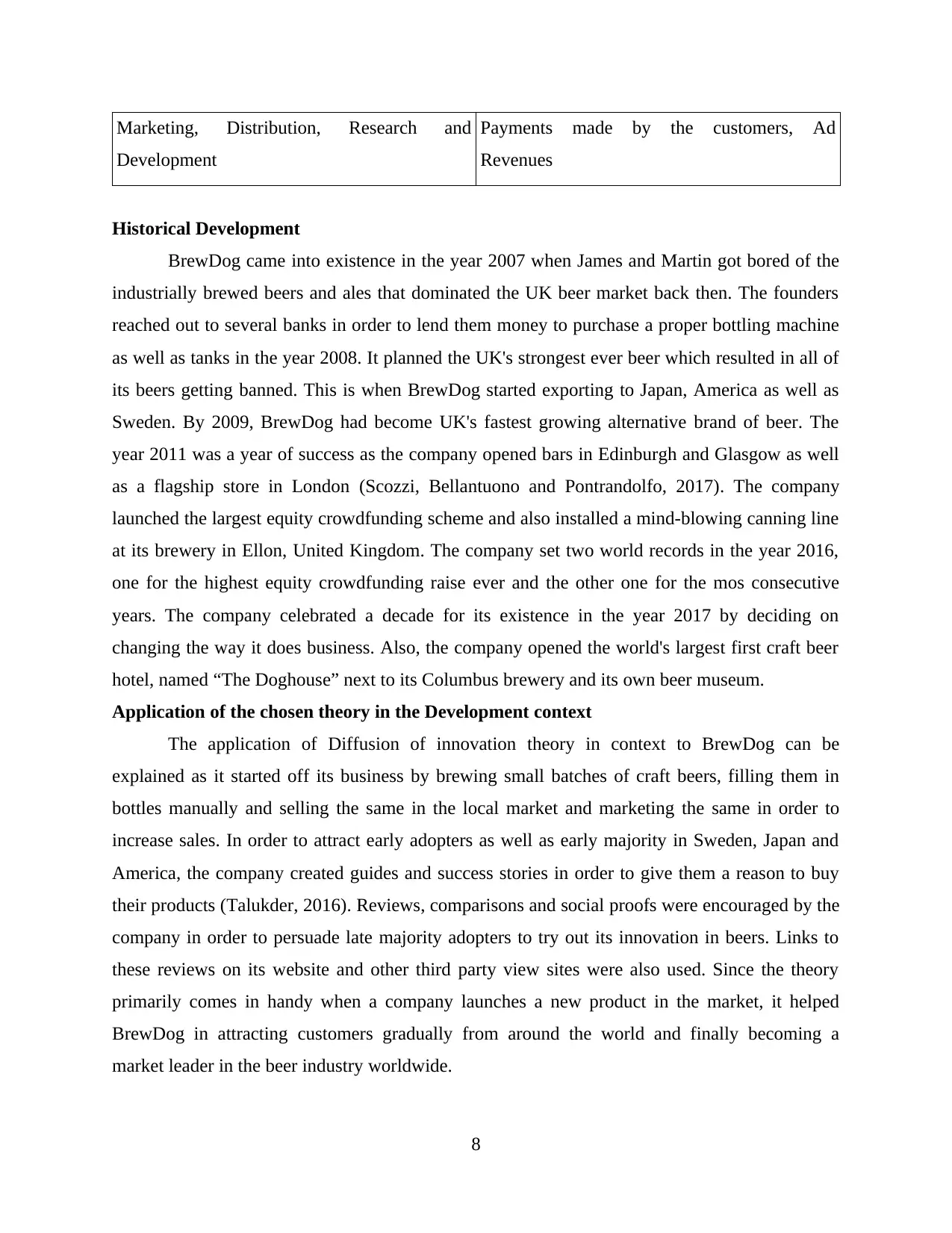
Marketing, Distribution, Research and
Development
Payments made by the customers, Ad
Revenues
Historical Development
BrewDog came into existence in the year 2007 when James and Martin got bored of the
industrially brewed beers and ales that dominated the UK beer market back then. The founders
reached out to several banks in order to lend them money to purchase a proper bottling machine
as well as tanks in the year 2008. It planned the UK's strongest ever beer which resulted in all of
its beers getting banned. This is when BrewDog started exporting to Japan, America as well as
Sweden. By 2009, BrewDog had become UK's fastest growing alternative brand of beer. The
year 2011 was a year of success as the company opened bars in Edinburgh and Glasgow as well
as a flagship store in London (Scozzi, Bellantuono and Pontrandolfo, 2017). The company
launched the largest equity crowdfunding scheme and also installed a mind-blowing canning line
at its brewery in Ellon, United Kingdom. The company set two world records in the year 2016,
one for the highest equity crowdfunding raise ever and the other one for the mos consecutive
years. The company celebrated a decade for its existence in the year 2017 by deciding on
changing the way it does business. Also, the company opened the world's largest first craft beer
hotel, named “The Doghouse” next to its Columbus brewery and its own beer museum.
Application of the chosen theory in the Development context
The application of Diffusion of innovation theory in context to BrewDog can be
explained as it started off its business by brewing small batches of craft beers, filling them in
bottles manually and selling the same in the local market and marketing the same in order to
increase sales. In order to attract early adopters as well as early majority in Sweden, Japan and
America, the company created guides and success stories in order to give them a reason to buy
their products (Talukder, 2016). Reviews, comparisons and social proofs were encouraged by the
company in order to persuade late majority adopters to try out its innovation in beers. Links to
these reviews on its website and other third party view sites were also used. Since the theory
primarily comes in handy when a company launches a new product in the market, it helped
BrewDog in attracting customers gradually from around the world and finally becoming a
market leader in the beer industry worldwide.
8
Development
Payments made by the customers, Ad
Revenues
Historical Development
BrewDog came into existence in the year 2007 when James and Martin got bored of the
industrially brewed beers and ales that dominated the UK beer market back then. The founders
reached out to several banks in order to lend them money to purchase a proper bottling machine
as well as tanks in the year 2008. It planned the UK's strongest ever beer which resulted in all of
its beers getting banned. This is when BrewDog started exporting to Japan, America as well as
Sweden. By 2009, BrewDog had become UK's fastest growing alternative brand of beer. The
year 2011 was a year of success as the company opened bars in Edinburgh and Glasgow as well
as a flagship store in London (Scozzi, Bellantuono and Pontrandolfo, 2017). The company
launched the largest equity crowdfunding scheme and also installed a mind-blowing canning line
at its brewery in Ellon, United Kingdom. The company set two world records in the year 2016,
one for the highest equity crowdfunding raise ever and the other one for the mos consecutive
years. The company celebrated a decade for its existence in the year 2017 by deciding on
changing the way it does business. Also, the company opened the world's largest first craft beer
hotel, named “The Doghouse” next to its Columbus brewery and its own beer museum.
Application of the chosen theory in the Development context
The application of Diffusion of innovation theory in context to BrewDog can be
explained as it started off its business by brewing small batches of craft beers, filling them in
bottles manually and selling the same in the local market and marketing the same in order to
increase sales. In order to attract early adopters as well as early majority in Sweden, Japan and
America, the company created guides and success stories in order to give them a reason to buy
their products (Talukder, 2016). Reviews, comparisons and social proofs were encouraged by the
company in order to persuade late majority adopters to try out its innovation in beers. Links to
these reviews on its website and other third party view sites were also used. Since the theory
primarily comes in handy when a company launches a new product in the market, it helped
BrewDog in attracting customers gradually from around the world and finally becoming a
market leader in the beer industry worldwide.
8
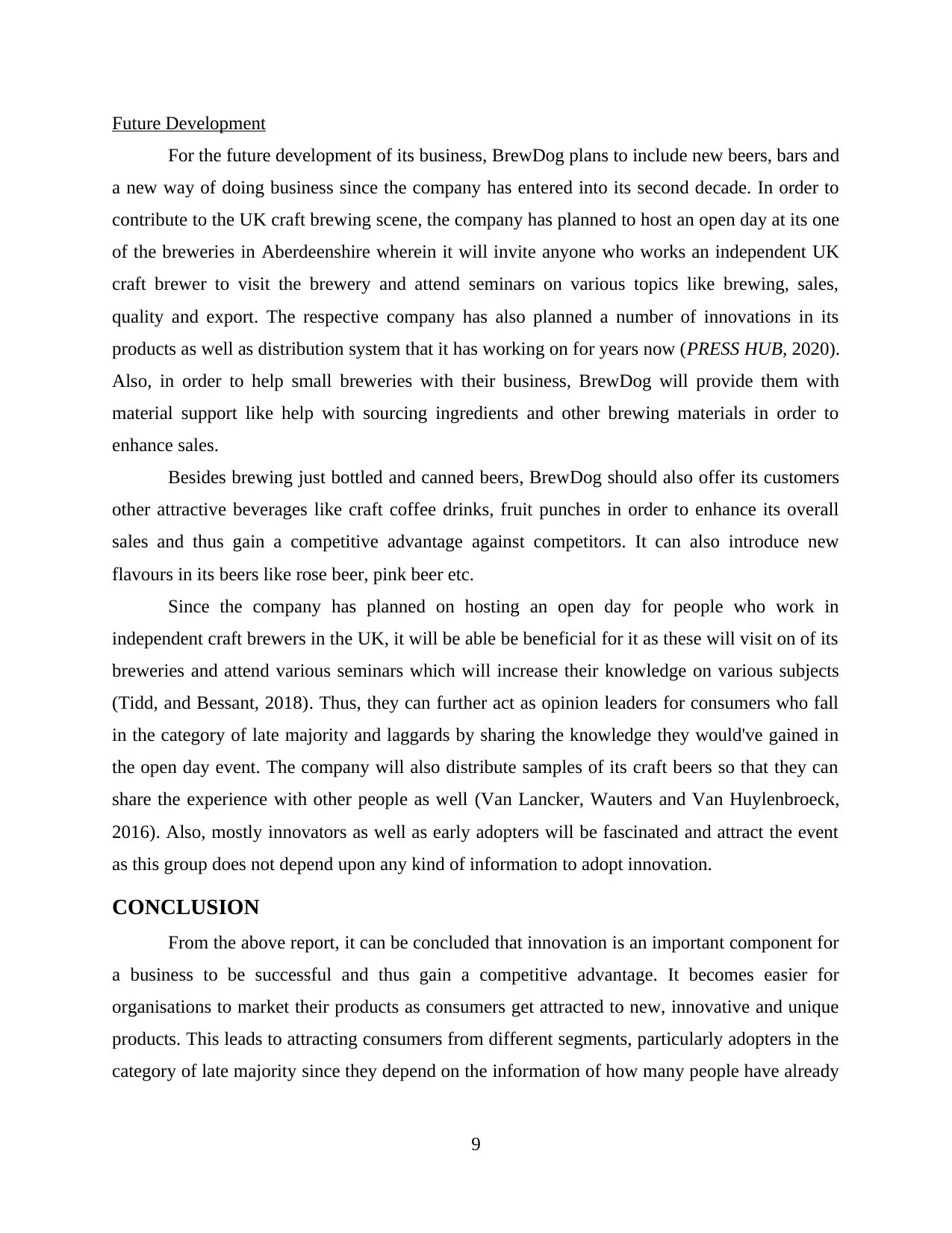
Future Development
For the future development of its business, BrewDog plans to include new beers, bars and
a new way of doing business since the company has entered into its second decade. In order to
contribute to the UK craft brewing scene, the company has planned to host an open day at its one
of the breweries in Aberdeenshire wherein it will invite anyone who works an independent UK
craft brewer to visit the brewery and attend seminars on various topics like brewing, sales,
quality and export. The respective company has also planned a number of innovations in its
products as well as distribution system that it has working on for years now (PRESS HUB, 2020).
Also, in order to help small breweries with their business, BrewDog will provide them with
material support like help with sourcing ingredients and other brewing materials in order to
enhance sales.
Besides brewing just bottled and canned beers, BrewDog should also offer its customers
other attractive beverages like craft coffee drinks, fruit punches in order to enhance its overall
sales and thus gain a competitive advantage against competitors. It can also introduce new
flavours in its beers like rose beer, pink beer etc.
Since the company has planned on hosting an open day for people who work in
independent craft brewers in the UK, it will be able be beneficial for it as these will visit on of its
breweries and attend various seminars which will increase their knowledge on various subjects
(Tidd, and Bessant, 2018). Thus, they can further act as opinion leaders for consumers who fall
in the category of late majority and laggards by sharing the knowledge they would've gained in
the open day event. The company will also distribute samples of its craft beers so that they can
share the experience with other people as well (Van Lancker, Wauters and Van Huylenbroeck,
2016). Also, mostly innovators as well as early adopters will be fascinated and attract the event
as this group does not depend upon any kind of information to adopt innovation.
CONCLUSION
From the above report, it can be concluded that innovation is an important component for
a business to be successful and thus gain a competitive advantage. It becomes easier for
organisations to market their products as consumers get attracted to new, innovative and unique
products. This leads to attracting consumers from different segments, particularly adopters in the
category of late majority since they depend on the information of how many people have already
9
For the future development of its business, BrewDog plans to include new beers, bars and
a new way of doing business since the company has entered into its second decade. In order to
contribute to the UK craft brewing scene, the company has planned to host an open day at its one
of the breweries in Aberdeenshire wherein it will invite anyone who works an independent UK
craft brewer to visit the brewery and attend seminars on various topics like brewing, sales,
quality and export. The respective company has also planned a number of innovations in its
products as well as distribution system that it has working on for years now (PRESS HUB, 2020).
Also, in order to help small breweries with their business, BrewDog will provide them with
material support like help with sourcing ingredients and other brewing materials in order to
enhance sales.
Besides brewing just bottled and canned beers, BrewDog should also offer its customers
other attractive beverages like craft coffee drinks, fruit punches in order to enhance its overall
sales and thus gain a competitive advantage against competitors. It can also introduce new
flavours in its beers like rose beer, pink beer etc.
Since the company has planned on hosting an open day for people who work in
independent craft brewers in the UK, it will be able be beneficial for it as these will visit on of its
breweries and attend various seminars which will increase their knowledge on various subjects
(Tidd, and Bessant, 2018). Thus, they can further act as opinion leaders for consumers who fall
in the category of late majority and laggards by sharing the knowledge they would've gained in
the open day event. The company will also distribute samples of its craft beers so that they can
share the experience with other people as well (Van Lancker, Wauters and Van Huylenbroeck,
2016). Also, mostly innovators as well as early adopters will be fascinated and attract the event
as this group does not depend upon any kind of information to adopt innovation.
CONCLUSION
From the above report, it can be concluded that innovation is an important component for
a business to be successful and thus gain a competitive advantage. It becomes easier for
organisations to market their products as consumers get attracted to new, innovative and unique
products. This leads to attracting consumers from different segments, particularly adopters in the
category of late majority since they depend on the information of how many people have already
9
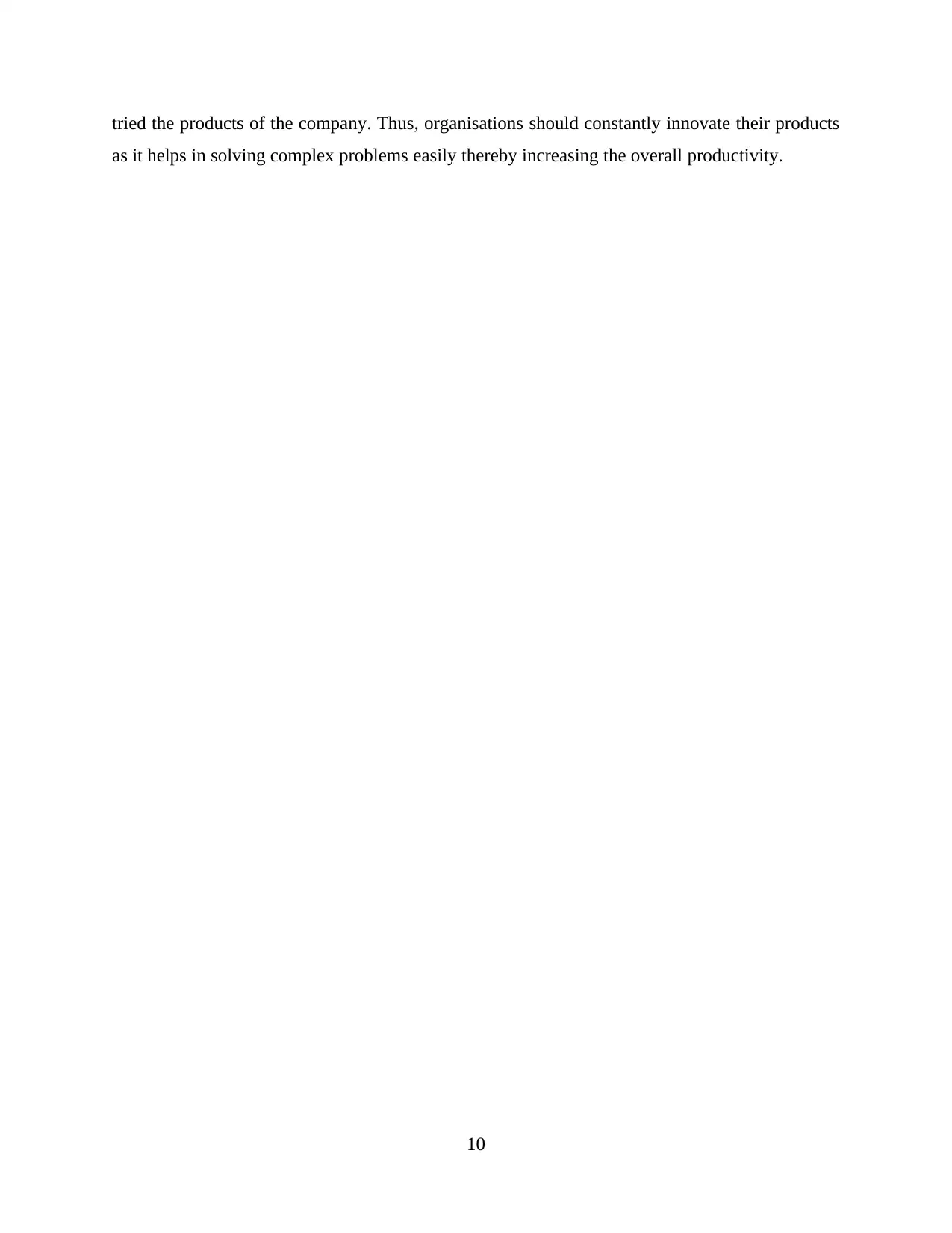
tried the products of the company. Thus, organisations should constantly innovate their products
as it helps in solving complex problems easily thereby increasing the overall productivity.
10
as it helps in solving complex problems easily thereby increasing the overall productivity.
10
Secure Best Marks with AI Grader
Need help grading? Try our AI Grader for instant feedback on your assignments.
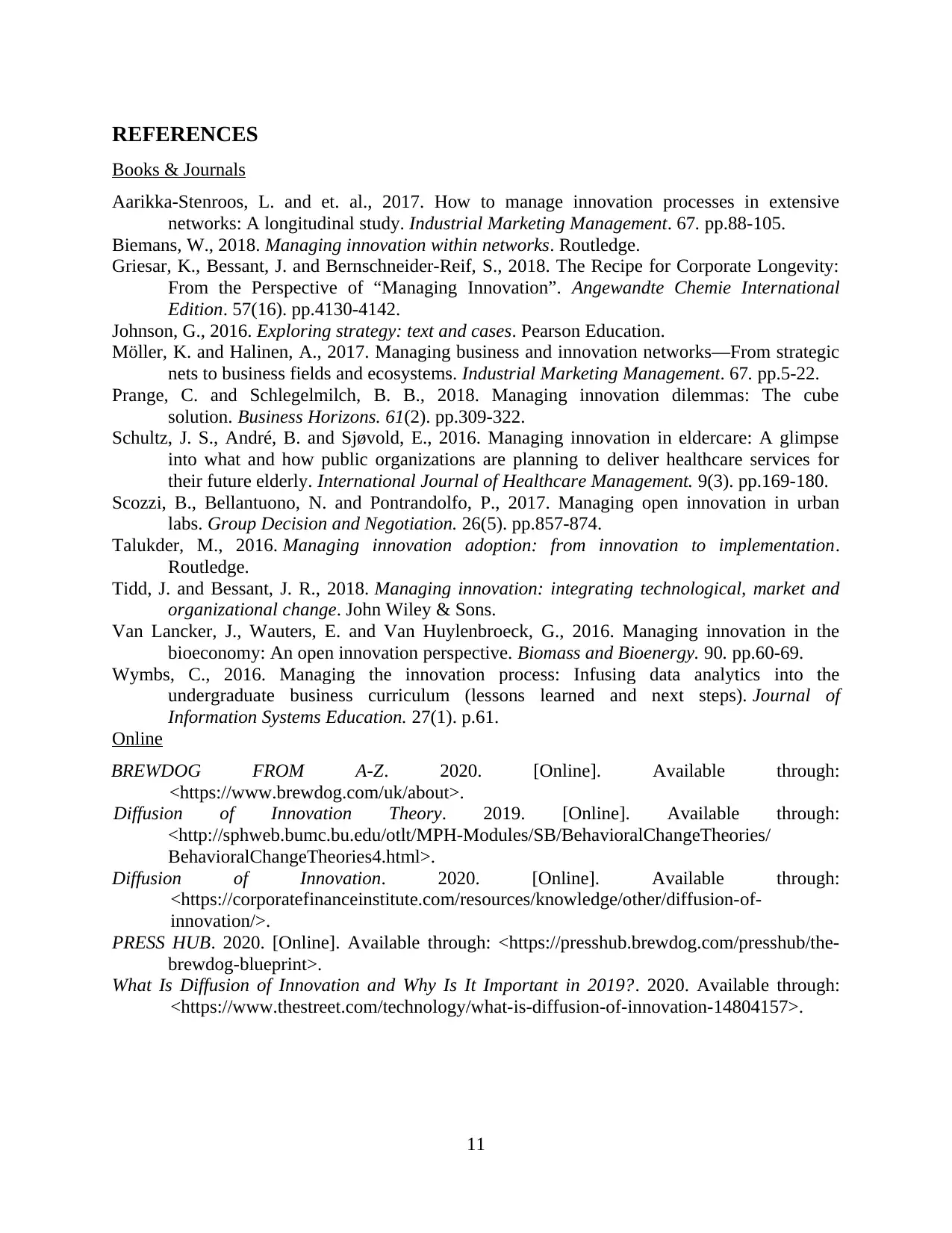
REFERENCES
Books & Journals
Aarikka-Stenroos, L. and et. al., 2017. How to manage innovation processes in extensive
networks: A longitudinal study. Industrial Marketing Management. 67. pp.88-105.
Biemans, W., 2018. Managing innovation within networks. Routledge.
Griesar, K., Bessant, J. and Bernschneider‐Reif, S., 2018. The Recipe for Corporate Longevity:
From the Perspective of “Managing Innovation”. Angewandte Chemie International
Edition. 57(16). pp.4130-4142.
Johnson, G., 2016. Exploring strategy: text and cases. Pearson Education.
Möller, K. and Halinen, A., 2017. Managing business and innovation networks—From strategic
nets to business fields and ecosystems. Industrial Marketing Management. 67. pp.5-22.
Prange, C. and Schlegelmilch, B. B., 2018. Managing innovation dilemmas: The cube
solution. Business Horizons. 61(2). pp.309-322.
Schultz, J. S., André, B. and Sjøvold, E., 2016. Managing innovation in eldercare: A glimpse
into what and how public organizations are planning to deliver healthcare services for
their future elderly. International Journal of Healthcare Management. 9(3). pp.169-180.
Scozzi, B., Bellantuono, N. and Pontrandolfo, P., 2017. Managing open innovation in urban
labs. Group Decision and Negotiation. 26(5). pp.857-874.
Talukder, M., 2016. Managing innovation adoption: from innovation to implementation.
Routledge.
Tidd, J. and Bessant, J. R., 2018. Managing innovation: integrating technological, market and
organizational change. John Wiley & Sons.
Van Lancker, J., Wauters, E. and Van Huylenbroeck, G., 2016. Managing innovation in the
bioeconomy: An open innovation perspective. Biomass and Bioenergy. 90. pp.60-69.
Wymbs, C., 2016. Managing the innovation process: Infusing data analytics into the
undergraduate business curriculum (lessons learned and next steps). Journal of
Information Systems Education. 27(1). p.61.
Online
BREWDOG FROM A-Z. 2020. [Online]. Available through:
<https://www.brewdog.com/uk/about>.
Diffusion of Innovation Theory. 2019. [Online]. Available through:
<http://sphweb.bumc.bu.edu/otlt/MPH-Modules/SB/BehavioralChangeTheories/
BehavioralChangeTheories4.html>.
Diffusion of Innovation. 2020. [Online]. Available through:
<https://corporatefinanceinstitute.com/resources/knowledge/other/diffusion-of-
innovation/>.
PRESS HUB. 2020. [Online]. Available through: <https://presshub.brewdog.com/presshub/the-
brewdog-blueprint>.
What Is Diffusion of Innovation and Why Is It Important in 2019?. 2020. Available through:
<https://www.thestreet.com/technology/what-is-diffusion-of-innovation-14804157>.
11
Books & Journals
Aarikka-Stenroos, L. and et. al., 2017. How to manage innovation processes in extensive
networks: A longitudinal study. Industrial Marketing Management. 67. pp.88-105.
Biemans, W., 2018. Managing innovation within networks. Routledge.
Griesar, K., Bessant, J. and Bernschneider‐Reif, S., 2018. The Recipe for Corporate Longevity:
From the Perspective of “Managing Innovation”. Angewandte Chemie International
Edition. 57(16). pp.4130-4142.
Johnson, G., 2016. Exploring strategy: text and cases. Pearson Education.
Möller, K. and Halinen, A., 2017. Managing business and innovation networks—From strategic
nets to business fields and ecosystems. Industrial Marketing Management. 67. pp.5-22.
Prange, C. and Schlegelmilch, B. B., 2018. Managing innovation dilemmas: The cube
solution. Business Horizons. 61(2). pp.309-322.
Schultz, J. S., André, B. and Sjøvold, E., 2016. Managing innovation in eldercare: A glimpse
into what and how public organizations are planning to deliver healthcare services for
their future elderly. International Journal of Healthcare Management. 9(3). pp.169-180.
Scozzi, B., Bellantuono, N. and Pontrandolfo, P., 2017. Managing open innovation in urban
labs. Group Decision and Negotiation. 26(5). pp.857-874.
Talukder, M., 2016. Managing innovation adoption: from innovation to implementation.
Routledge.
Tidd, J. and Bessant, J. R., 2018. Managing innovation: integrating technological, market and
organizational change. John Wiley & Sons.
Van Lancker, J., Wauters, E. and Van Huylenbroeck, G., 2016. Managing innovation in the
bioeconomy: An open innovation perspective. Biomass and Bioenergy. 90. pp.60-69.
Wymbs, C., 2016. Managing the innovation process: Infusing data analytics into the
undergraduate business curriculum (lessons learned and next steps). Journal of
Information Systems Education. 27(1). p.61.
Online
BREWDOG FROM A-Z. 2020. [Online]. Available through:
<https://www.brewdog.com/uk/about>.
Diffusion of Innovation Theory. 2019. [Online]. Available through:
<http://sphweb.bumc.bu.edu/otlt/MPH-Modules/SB/BehavioralChangeTheories/
BehavioralChangeTheories4.html>.
Diffusion of Innovation. 2020. [Online]. Available through:
<https://corporatefinanceinstitute.com/resources/knowledge/other/diffusion-of-
innovation/>.
PRESS HUB. 2020. [Online]. Available through: <https://presshub.brewdog.com/presshub/the-
brewdog-blueprint>.
What Is Diffusion of Innovation and Why Is It Important in 2019?. 2020. Available through:
<https://www.thestreet.com/technology/what-is-diffusion-of-innovation-14804157>.
11
1 out of 11
Related Documents
Your All-in-One AI-Powered Toolkit for Academic Success.
+13062052269
info@desklib.com
Available 24*7 on WhatsApp / Email
![[object Object]](/_next/static/media/star-bottom.7253800d.svg)
Unlock your academic potential
© 2024 | Zucol Services PVT LTD | All rights reserved.





